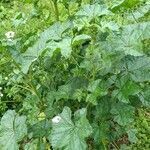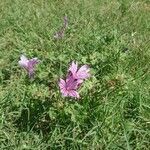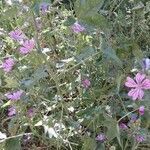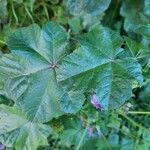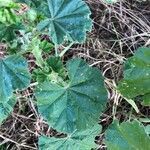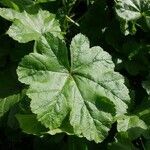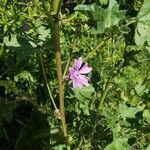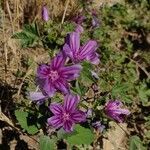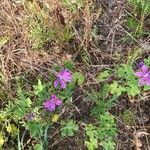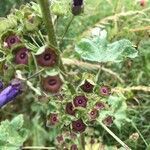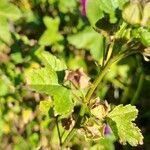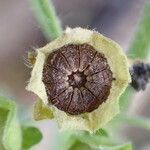Perennial, ascending to erect herb. Stems glabrous to densely hairy with simple and stellate hairs. Lvs ± glabrous to densely hairy, reniform to suborbicular, obtuse to cordate at base, shallowly or moderately 3-5-(7)-palmately lobed and crenate, 1-15-(20) cm diam.; petioles 1-15-(30) cm long; stipules narrowly to broadly ovate with acute apex, 3-10 mm long. Fls 2-10 in axillary clusters or irregular racemes; fruiting pedicels 10-45 mm long; epicalyx segments narrow-oblong to elliptic-ovate, somewhat < calyx; calyx teeth broadly ovate with acute apex, sparsely to densely hairy with stellate or simple hairs and ciliate, not enlarged at fruiting; petals from deep pink to reddish or bluish purple with darker markings, 2-5× as long as calyx, 12-30 mm long. Mericarps 8-12-(15) per fr., usually glabrous, strongly reticulately veined on back; edges sharply angled but not winged.
Erect biennial, 4–10 dm, hirtellous to glabrate; lvs orbicular or reniform in outline, shallowly 3–7-lobed, the lobes broadly rounded, serrate; petioles hairy only or chiefly in a single line on the upper side; bractlets oblong to ovate or obovate; fls fascicled in the upper axils, on pedicels to 5 cm; pet red-purple, 2–2.5 cm; mature carpels rugose-reticulate on the back, glabrous or sparsely hairy; 2n=42. Native of Eurasia, escaped from cult. here and there in our range. June–Aug.
A plant which has a two year life cycle. It grows to 0.5-1.5 m high. It is often like a shrub. The leaves are hairy and floppy. Each leaf is made up of 5-7 lobes which are wavy. The leaves near the base are 5-10 cm across and rounded in outline with a heart shaped base. The upper leaves are more deeply divided. It has large flowers. They are 4 cm across. They are rosy purple with dark stripes in the centre. The fruit are small brown wrinkled nutlets.
Leaf-lamina of basal leaves 5–10 cm. in diam., shallowly crenate, of upper leaves ± deeply 5-lobed with crenulate-serrate lobes, glabrous except for a strigose pubescence on the main veins; petiole (2) 4–9 (16) cm. long, pubescent in an adaxial groove, otherwise glabrous; stipules 5–10 × 2–5 mm. obliquely ovate, serrate, acuminate.
Flowers 2·5–5 cm. in diam., mauve-purple, or light magenta with darker purple veins, 2–5-fasciculate or in short racemes; pedicels 1–2 cm. long, glabrous or sparsely hirsute.
Erect perennial up to c. 1 m. tall; stems sparsely hirsute with simple or stellate usually spreading hairs.
Caule erecto herbaceo, foliis lobatis obtutis, pedunculis petiolisque pilotis.
Calyx stellate-pilose, not enlarged in fruit; lobes ovate-deltoid.
Bracts of epicalyx 2/3 the length of the calyx, oblong-lanceolate.
Mericarps 9–11, dorsally reticulate, usually glabrous.
Petals 1·5–2 cm. long; claw barbate.
Staminal tube setose.
